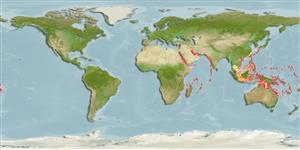Common names from other countries
>
Mulliformes (Goatfishes) >
Mullidae (Goatfishes)
Etymology: Parupeneus: Latin, parum, parvum = small + Peneus, the name of a river.
Environment: milieu / climate zone / depth range / distribution range
Ecologia
marino; salmastro associati a barriera corallina; distribuzione batimetrica 1 - 45 m (Ref. 96856). Subtropical
Indian Ocean: Red Sea into the Gulf of Aden and recorded from Socotra (Ref. 54393). Suez canal migrant and now established in the eastern Mediterranean.
Size / Peso / Age
Maturity: Lm ? range ? - ? cm
Max length : 28.0 cm TL maschio/sesso non determinato; (Ref. 2272); common length : 25.0 cm TL maschio/sesso non determinato; (Ref. 5450); peso massimo pubblicato: 275.30 g (Ref. 121845)
Spine dorsali (totale) : 8; Raggi dorsali molli (totale) : 9; Raggi anali molli: 7. Diagnosis: Pectoral rays 14-17 (usually 16). Gill rakers 7-9 + 23-26 (total 30-34). Body relatively elongate, the depth 3.65-4.2 in SL; head length (HL) 2.9-3.25 in SL; snout length 1.7-1.9 in HL; barbel length 1.4-1.5 in HL; longest dorsal spine 1.5-1.7 in HL; penultimate dorsal ray 1.15-1.25 in length of last dorsal ray; pectoral-fin length 1.4-1.65 in HL; pelvic-fin length 1.4-1.6 in HL. A broad black stripe is present from side of upper lip through eye along upper side of body, ending beneath posterior part of second dorsal fin; body above stripe grayish green, the scale edges yellow; body below stripe white, the scale edges narrowly reddish; caudal peduncle yellow dorsally with an irregular roundish black spot, mostly above lateral line; caudal fin yellow; second dorsal and anal fins with narrow blue and yellow stripes; peritoneum pale (Ref. 54393).
The most common goatfish in shallow water in the Red Sea. Usually found on sand bottoms near coral reefs (Ref. 3470). Feeds on invertebrates that live on sand (Ref. 13550).
Life cycle and mating behavior
Maturities | Riproduzione | Spawnings | Egg(s) | Fecundities | Larve
Randall, J.E., 2004. Revision of the goatfish genus Parupeneus (Perciformes: Mullidae), with descriptions of two new species. Indo-Pac. Fish. (36):64 p. (Ref. 54393)
IUCN Red List Status (Ref. 130435)
CITES (Ref. 128078)
Not Evaluated
Threat to humans
Harmless
Human uses
Pesca: scarso interesse commerciale; Acquario: Commerciale
Strumenti
Special reports
Download XML
Fonti Internet
Estimates based on models
Preferred temperature (Ref.
115969): 24.7 - 29.1, mean 27.7 (based on 910 cells).
Phylogenetic diversity index (Ref.
82804): PD
50 = 0.5000 [Uniqueness, from 0.5 = low to 2.0 = high].
Bayesian length-weight: a=0.00933 (0.00524 - 0.01663), b=3.10 (2.95 - 3.25), in cm Total Length, based on LWR estimates for this species & Genus-body shape (Ref.
93245).
Trophic level (Ref.
69278): 3.5 ±0.3 se; based on diet studies.
Resilienza (Ref.
120179): Alto, tempo minimo di raddoppiamento della popolazione meno di 15 mesi (K>1).
Fishing Vulnerability (Ref.
59153): Low vulnerability (15 of 100).
